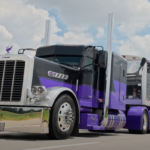Truckers and industry experts are expressing that the trucking sector, which was once highly profitable, has been adversely affected by a significant shortage of drivers. Prior to the pandemic, there were speculations about a scarcity of truck drivers, but as the pandemic unfolded, this concern became more prominent. The surge in demand for freight services during the pandemic, coupled with the halt in other industries, drew many newcomers to the trucking field, hoping to capitalize on the booming market. However, the situation has now taken a downturn, and those who initially saw profits are now stuck with trucks they can’t afford and cargo loads so poorly compensated that they no longer justify the expense of diesel fuel.
“What happened in the middle of 2020 was unprecedented and is still playing out in the market today, in terms of the number of trucks that entered the market,” said Dean Croke, principal freight analyst at DAT Freight and Analytics, to TIME.
Between June 2020 and July 2023, the count of registered for-hire carriers surged by an astounding 96%, surging from 241,835 to 475,371. This remarkable upswing was a direct response to the surging demand for goods a few months into the pandemic, a decline in diesel fuel expenses, and government loans that offered vital support to carriers during the initial pandemic-induced slowdown.
The heightened demand motivated both novice drivers to embark on their careers and seasoned drivers to transition away from larger companies, opting instead to establish their own independent authorities in the industry.
“You would have had to be very bad [at the job] to lose money,” Croke said of the recent boom.
Subsequently, in the year 2022, there was a significant and abrupt surge in diesel fuel prices, which posed escalating challenges for independent truckers who had established their own authority in the industry. Additionally, the sudden surge in the number of truck drivers combined with a reduction in the volume of available freight has resulted in an oversupply of drivers in the market. This oversaturation has led to a situation where the number of drivers surpasses the demand for freight services, consequently causing a continuous decline in the rates offered for transporting goods.
“The shortage is just something the big companies make up,” said Jacqueline Jolly, who entered the trucking industry with her husband in 2020 after their construction business slowed.
According to Jolly, when she and her husband entered the trucking industry in 2020, they were receiving generous payments, sometimes up to $5 per mile for their services. At that time, diesel fuel costs were relatively low, and the compensation was quite lucrative. Encouraged by these favorable conditions, they made the decision to take out a loan and invest $80,000 in purchasing a second truck with the intention of hiring an additional driver.
However, their fortunes took a swift turn when diesel fuel prices surged, and the rates for trucking services plummeted, resulting in a drastic reduction of their earnings by more than half. Consequently, they were compelled to surrender their second truck, which had depreciated significantly in value and was now worth only $30,000. The couple is still grappling with the financial burden they incurred during the highs and lows of the industry’s boom and bust cycle.
“When the rates went down, that really killed us,” she said. “We were like, what the heck, we can’t survive on this.”
“We certainly hear from many that are feeling the impact of the current overcapacity that exists in trucking—there’s lots of competition among lots of truckers for not enough freight,” says Todd Spencer, president of the Owner-Operator Independent Drivers Association. “The problem that much of trucking has is that they can’t retain drivers. That doesn’t indicate the problem is the workers, that indicates the problem is with the job.”
The encouraging aspect of the current situation is that it’s not the first time the freight market has faced a recession, so experts have some insight into what to anticipate. Boom and bust cycles have been a recurring pattern in the trucking industry since the 1980s, and according to experts like Croke, this particular freight market recession is projected to be about 75% through its course. The cycle is expected to reach its lowest point as more Owner Operators accumulate debt and exit the market. While this is undoubtedly challenging for those Owner Operators, it is likely to be advantageous for the drivers who remain in the market. As these Owner Operators depart, the demand for drivers is anticipated to increase once again, along with the compensation rates for their services.





